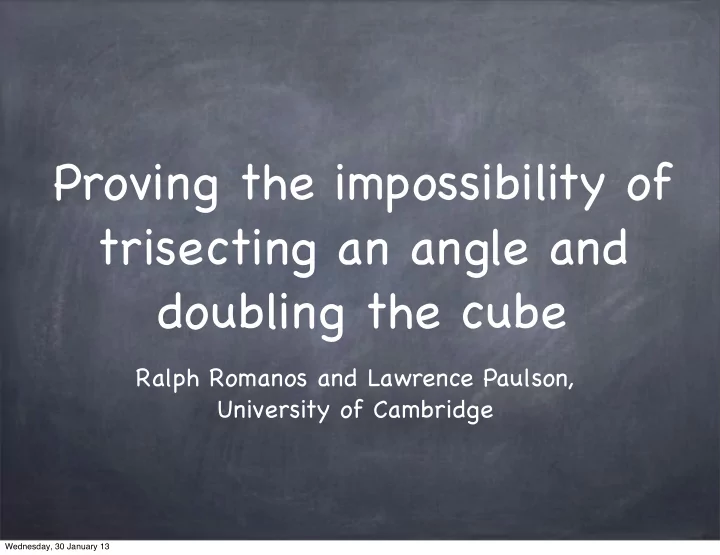

Proving the impossibility of trisecting an angle and doubling the cube Ralph Romanos and Lawrence Paulson, University of Cambridge Wednesday, 30 January 13
Duplicating the cube (using only ruler and compass) Wednesday, 30 January 13
… and trisecting the angle Wednesday, 30 January 13
A brief history Posed by classical Greek mathematicians Proved impossible in the 19th century (Wantzel, 1837) Recently included on a list of 100 well- known theorems John Harrison had already formalised a proof using HOL Light. Wednesday, 30 January 13
An elementary proof Textbook proofs of the theorem are built upon Galois theory or field extensions. The Isabelle formalization follows, but simplifies, Jean-Claude Carrega: J. C. Carrega. Theory of fields. Rules and a pair of compasses. Hermann, 1981. Wednesday, 30 January 13
Core concepts R ADICAL VALUES : those C ONSTRUCTIBLE POINTS : constructed using the those having rational coordinates, or operations + − × / √ defined as the intersection of two lines a line and a circle two circles Wednesday, 30 January 13
Simplifying Wantzel’ s theorem The full theorem refers to a series of field extensions ending in the construction of x — which is constructible iff it is the root of an irreducible polynomial of degree 2 n . Therefore, certain regular polygons (e.g. seven-sided) are not constructible. Our proof replaces field extensions by radical values and only considers cubic equations. Wednesday, 30 January 13
Lemma 1: (on a cubic equation with rational coefficients) If it has a RADICAL root …then it has a RATIONAL root. Wednesday, 30 January 13
Lemma 2 All constructible points have radical coordinates Wednesday, 30 January 13
Lemmas 3 and 4: These equations have no rational roots The first corresponds to duplicating the cube … and the second to trisecting a 60° angle. Wednesday, 30 January 13
Notes on the Isabelle Formalization MANY tedious calculations Over 1500 lines; 62 lemmas and theorems 3 times the length of the informal mathematics Wednesday, 30 January 13
Formal preliminaries points in two dimensions shown to be a metric space basic definitions of plane geometry radical values (defined inductively) radical expressions: an abstract syntax for radical values Wednesday, 30 January 13
Normal forms of radical expressions Every nontrivial radical expression e can be written in the form a+b √ r … where the radicals in a, b, r are only those of e, excluding r itself. Wednesday, 30 January 13
On cubic equations Consider a field F ⊆ � containing the integers. If cubic equation over this field has a real root of the form u+v √ s (for u, v, s ∈ F) …then it has a root in F . Proof: a huge case analysis Wednesday, 30 January 13
Simplifying the roots of cubic equations The previous result lets us decrease the number of radicals in a root of a cubic (working with formalised expressions) Therefore, by induction on the number of radicals… if there is a RADICAL root, then there is a RATIONAL root. Wednesday, 30 January 13
Constructible points A straightforward inductive definition T HEOREM : the coordinates of constructible points are radical values P ROOF : the roots of various quadratic equations are radical values. Wednesday, 30 January 13
Completing the proof: detailed calculations the cubic equations for duplicating the cube and trisecting the angle … have no rational solutions … and therefore no constructible ones Wednesday, 30 January 13
Trisecting the angle cos 60° equals ½ , so a 60° angle is constructible cos 20° is the solution of a cubic, and therefore not constructible Therefore, a 60° angle cannot be trisected. Wednesday, 30 January 13
Final remarks This was the MPhil project of the first author at Cambridge. Detailed calculations seem inevitable, but with some effort, the proofs can be simplified. A formal theory of field extensions would allow the full result to be reproduced. Wednesday, 30 January 13
Recommend
More recommend